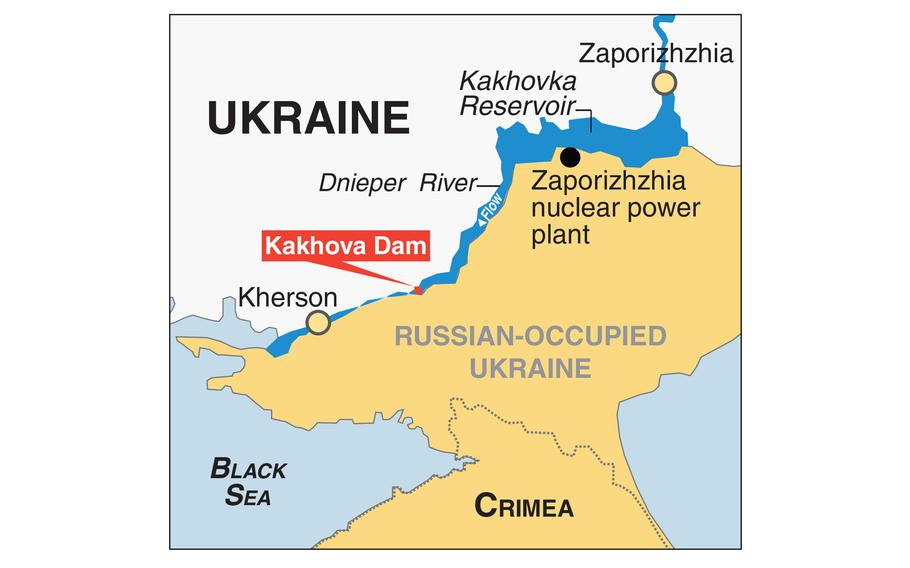
(Noga Ami-rav/Stars and Stripes)
A major dam and a hydroelectric power plant close to the front lines in southern Ukraine were damaged in a blast early Tuesday.
Thousands of people have been ordered to evacuate as officials warn of a risk of catastrophic flooding. Ukraine and Russia both blamed each other for the explosion.
Here’s what we know so far.
Where is the Kakhovka dam, and why is it important?
The Kakhovka dam sits on the river Dnieper in Ukraine’s southern Kherson region. The river is the dividing front line between the Ukrainian-controlled Kherson region and the Russian-occupied Kherson region.
The Russians gained control over the dam and its hydroelectric power station in the first days of the invasion when they occupied the adjacent town of Nova Kakhovka.
The dam’s reservoir holds as much water as the Salt Lake in Utah. The reservoir provides a key water supply for Russian-occupied Crimea.
How badly damaged is the dam?
Videos shared Tuesday morning by Ukraine’s public broadcaster Suspilne appear to show the dam with its hydroelectric power plant almost completely submerged.
Both Ukraine and Russia’s occupying authorities in the region said the dam was not destroyed. A spokeswoman for Ukraine’s southern command, Natalia Humeniuk, said, nevertheless, the dam was severely damaged and there is a risk of rising water levels.
The head of the Russian-occupied administration, Vladimir Leontyev, who announced a local state of emergency in the area, said the gate valves of the dam were destroyed and the hydroelectric power plant would have to be rebuilt from scratch.
“As a result, water from the Kakhovka reservoir began to be discharged downstream uncontrollably,” Leontyev said.
How dangerous is the flooding from Kakhovka dam?
Ukraine and Russia’s occupying authorities are taking markedly different approaches to the risk posed by flooding.
Leontyev told residents that everything is under control and that evacuations will only take place from the areas that are flooded. “There is no panic. All operational services have been working since night,” he said, adding that people are being evacuated from flooded areas.
However, Ukrainian Prime Minister Denys Shmyhal said 80 settlements downstream from the dam are at risk of flooding, and Ukrainian authorities have ordered a mass evacuation.
Earlier, a spokesperson for Oleksandr Prokudin, head of the Ukrainian-controlled part of Kherson, said water levels would reach a critical height around 11 a.m. Kyiv time and that from there, officials would monitor the drop in levels.
Prokudin’s spokesperson also urged residents in the occupied areas, on the left bank of Kherson “to immediately leave unsafe areas and if you cannot evacuate independently . . . to move away from the Dnieper River.” Ukraine’s interior ministry said more than 800 people were promptly evacuated from the affected areas.
Prokudin said on national TV that 16,000 people are in what he described as the “critical” danger zone on the right bank of the river.
Yevhen Korzhov, a scientist from Kherson’s department of aquatic bioresources and aquaculture, said the affected area was likely to be around 38.6 square miles, from Nova Kakhovka to Kizomys.
However, the worst hit would be the areas closest to the dam, in the upper parts of the Dnieper River where the water levels may rise by 5 feet from their current levels. At the end of the Dnieper River, he predicted, levels would rise by around 1 foot.
“This situation is not dangerous for the lower Dnieper, as the rise in the level will be short-term, no more than a week,” Korzhov said.
Is the nearby Zaporizhzhia nuclear plant at risk?
There have been concerns that the damage to the dam could also impact the Zaporizhzhia nuclear plant, Europe’s largest.
Rafael Mariano Grossi, director general of the International Atomic Energy Agency, said the destruction of the dam has significantly reduced water levels in the reservoir used to supply cooling water the plant. The IAEA is in charge of monitoring the plant on behalf of the United Nations.
Grossi warned that “absence of cooling water in the extended cooling systems for an extended period of time would cause fuel melt and inoperability of the emergency diesel generators.” However, he added, at present the plant’s reservoir is intact, and there is no immediate risk.
Petro Kotin, the head of Ukraine’s state nuclear company, Energoatom, told Ukrainian media that the Zaporizhzhia nuclear plant is not at risk. Kotin said the plant is cooled by its own pond, which is separated from the Kakhovka reservoir.
Russian energy officials also said the plant is not in jeopardy. Renat Karchaa, an adviser to Russian nuclear plant operator Rosenergoatom, told Interfax that specialists were using “other technical methods” to compensate for the decrease in water levels at the Kakhovka reservoir.
Who is responsible for the blast that damaged the dam?
Ukraine and Russia have emphatically blamed each other.
Humeniuk accused the Russian side of blowing up the dam, saying it was not hit by a rocket but apparently was destroyed by explosives. Ukrainian President Volodymyr Zelenskyy accused Russia of blowing up the hydroelectric power plant from inside, and he described Russian forces as “terrorists.”
In Moscow, Kremlin press secretary Dmitry Peskov said the destruction of the dam was deliberate “sabotage by the Ukrainian side” and was born out of Ukraine’s desire to cut off water supplies to Crimea, which Russia illegally annexed in 2014.
Peskov also suggested that the “sabotage” was carried out because Ukraine’s much-anticipated counteroffensive was failing. Ukrainian military officials denied that the counteroffensive has begun and described Peskov’s claims as “delusional.”